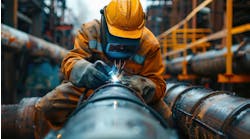Latest from Home
Have We Reached Critical Mass in the Trades?
Industry Econ Forecast 2025
Sponsored
VIA E-MAIL — I saw Dave Yates' column about swimming pools at contractormag.com and have a question about gas lines for pool heaters ("Spring means it's pool heater mania time," May, pg. 52).
We plan to install a 333,000 Btuh heater and feed it natural gas. Do we need a dedicated gas line from the meter, or can we just splice into the existing gas lines in the house? I have heard that a unique line prevents heater startup from sucking all the gas out of the lines and extinguishing pilot lights. Is this a valid issue these days?
The heater will be about 60 ft. from the nearest gas users (furnace and water heater). We live in California and will not use the pool heater that often.
PETER MCINTOSH
Dave Yates replies: Two primary issues come into play:
- Can the existing gas meter support the load? In other words, can it pass enough gas (no pun intended) if all appliances connected are "on"?
- Is that existing gas line large enough to carry the total connected load? I doubt it is, in which case a dedicated line is typically the easiest and least expensive route.
Also important is the Btu content of your natural gas and the pressure at which it's delivered. For my area, a 60-ft. run of natural gas for that load would dictate we utilize 1.25-in. plastic piping with risers at both ends (outdoors) and then black iron piping at both ends to connect to the pool heater and gas meter or existing piping.
If your furnace is 80,000 Btuh and you have a gas water heater (tank style) with 50,000 Btuh, you'll have a combined load of 463,000 Btuh. If you have 40 ft. of gas piping (each ell = 5 ft. of straight piping) up to the branch lines serving the furnace, that portion (in my area) would need to be 1.25-in. diameter. The additional 60-ft. run would transition to 1.25-in. SDR-35 plastic pipe that's buried with a bed of crushed rock dust, with a barrier warning tape on top of that bed and a tracer wire for electronic line detection laid in the trench prior to backfilling.
Attaching a large load to an undersized line can indeed pull enough to cause pilot outages, but the larger concern is the potential for starving other appliances and creating potential combustion issues that could ruin the equipment or create a carbon monoxide incident within the home.

